Россия
Россия
УДК 63 Сельское хозяйство. Лесное хозяйство. Охота. Рыбное хозяйство
ГРНТИ 69.25 Аквакультура. Рыбоводство
ОКСО 110000 СЕЛЬСКОЕ И РЫБНОЕ ХОЗЯЙСТВО
ББК 472 Рыбное хозяйство
Белоногая креветка Penaeus vannamei (Boone, 1931) – один из наиболее популярных и перспективных объектов мировой аквакультуры. В статье рассмотрены возможности и перспективы культивирования этого вида в России, результаты исследований влияния температуры и солености на выживаемость, рост, активность и потребление кормов белоногой креветкой. Определены критические значения температуры и солености для данного вида. Наиболее перспективными, для культивирования белоногой креветки, являются южные регионы России, имеющие протяженную морскую береговую линию или большое количество соленых озер. Для повышения эффективности культивирования рекомендуется использовать технологии, совмещающие товарное прудовое выращивание с предварительным подращиванием молоди в установках замкнутого водоиспользования.
белоногая креветка, Penaeus vannamei, аквакультура, питание, соленость, температура; критические показатели, границы оптимума, УЗВ
1. Fishery and Aquaculture Statistics. Global aquaculture production 1950-2019 (FishstatJ). [Электронный ресурс] // FAO Fisheries and Aquaculture Department. Rome. Updated 2021. URL: https://www.fao.org/fishery/statistics/software/fishstatj/en (date accessed: August 26, 2021)
2. Ковачева Н.П. Выращивание белоногой креветки (Penaeus vannamei, Penaeidae, Decapoda) в рециркуляционных установках: первый опыт экспериментального культивирования вида в России / Н.П. Ковачева, Р.Р. Борисов, И.Н. Никонова, Н.В. Кряхова, Е.С. Чертопруд, Р.О. Лебедев // Рыбное хозяйство. - 2018. - № 3. - С. 62-69.
3. Ковачева Н.П. Рост и развитие белоногой креветки (Penaeus vannamei, Penaeidae, Decapoda) при питании разными типами комбикормов в искусственных условиях / Н.П. Ковачева, Р.Р. Борисов, И.Н. Никонова, Е.С. Чертопруд // Рыбное хозяйство. - 2020. - № 1. - С. 78-82.
4. Чемерис А. Деликатес отечественного производства: чем уникальна крымская креветка / А. Чемерис // Русская рыба. - 2020. - № 2. - С. 66-69.
5. Wickins J.F. Crustacean farming ranching and culture (Second Edition) / J.F. Wickins, D.O’C. Lee - Wiley Blackwell, 2002. - 464 p.
6. Козлов В.И. Справочник рыбовода / В.И. Козлов, Л.С. Абрамович. - М.: Россельхозиздат, 1980. - 220 с.
7. Добровольский А.Д. Моря СССР / А.Д. Добровольский, Б.С. Залогин - М.: Изд-во МГУ, 1982. - 192 с.
8. СП 131.13330.2020 Строительная климатология СНиП 23-01-99* Официальное издание. М.: Стандартинформ, 2021
9. Климат морей России [Электронный ресурс] // Межведомственная федеральная информационная система - ЕСИМО. URL: http://esimo.ru/portal/portal/esimo-user/services/climate (дата обращения: 26.08.2021).
10. Вода России [Электронный ресурс] // Энциклопедия URL: https://water-rf.ru Регионы_России (дата обращения: 26.08.2021)
11. Перечень рыбохозяйственных нормативов: предельно допустимых концентраций (ПДК) и ориентировочно безопасных уровней воздействия (ОБУВ) вредных веществ для воды водных объектов, имеющих рабохозяйственное значение // М.: ВНИРО, 1999. - 304 с.
12. Wyban J.A., Sweeney J.N. Intensive shrimp production technology / J.A. Wyban, J.N. Sweeney - High Health Aquaculture Inc., Hawaii. 1991. 158 p.
13. Rosenberry B. World shrimp farming 2002 / B. Rosenberry. - Shrimp News International, 2002. - 276 p.
14. Briggs M. Cultured Aquatic Species Information Programme. Penaeus vannamei. Cultured Aquatic In: FAO Fisheries and Aquaculture Department [Электронный ресурс] / M. Briggs // - Режим доступа: http://www.fao.org/fishery/culturedspecies/Penaeus_vannamei/en. Rome. (Дата обращения 26.08.2021).
15. Kitani H. Larval development of the White Shrimp Penaeus vannamei Boone reared in the laboratory and the statistical observation of its naupliar stages / H. Kitani // Bull. Jap. Soc. Sci. Fish. - 1986. - V. 52. - Pp. 1131-1139.
16. Wyban J. Temperature effects on growth, feeding rate and feed conversion of the Pacific white shrimp (Penaeus vannamei) / J. Wyban, W.A. Walsh, D.M. Godin // Aquaculture. - 1995. - V. 138. - Pp. 267-279.
17. Juarez L.M. Maturation and larval rearing of the Pacific white shrimp, Penaeus vannamei / L.M. Juarez, S.M. Moss, E. Figueras // The Shrimp Book. Nottingham: University Press, 2010. - Pp. 305-352.
18. Cobo M.L. Intensification of white shrimp Litopenaeus vannamei (Boone) larviculture / M.L. Cobo // Ph.D. thesis. Ghent: University Belgium, 2013. - 219 p.
19. Van Wyk P.M. Water Quality Requirements and Management / P. M. Van Wyk, J. Scarpa. In: Farming marine shrimp in recirculating freshwater systems. - Chap. 8. / P.M. Van Wyk, J. Scarpa - Florida: Florida Department of Agriculture and Consumer Services - Harbor Branch Oceanic Institute, 1999. - Pp. 141-162.
20. Suantika G. Development of a zero water discharge (ZWD) - recirculating aquaculture system (RAS) hybrid system for super intensive white shrimp (Litopenaeus vannamei) culture under low salinity conditions and its industrial trial in commercial shrimp urban farming in Gresik, East Java, Indonesia / G. Suantika, M.L. Situmoranga, J.B. Kurniawan, Sh.A. Pratiwi, P. Aditiawatia, D.I. Astuti, F.F.N. Azizah, Y.A. Djohan, U. Zuhri, T.M. Simatupang // Aquacultural Engineering. - 2018. - V. 82. - Pp. 12-24.
21. Fan L. Comparative proteomic identification of the hemocyte response to cold stress in white shrimp, Litopenaeus vannamei / L. Fan, A. Wang, Y. Wu // Journal of Proteomics. - 2013. - V. 80. - Pp. 196-206.
22. Huang W. Transcriptomic analyses on muscle tissues of Litopenaeus vannamei provide the first profile insight into the response to low temperature stress / W. Huang, C. Ren, H. Li, D. Huo, Y. Wang, X. Jiang // PLoS One. 2017. 12:e178604.https://doi.org/10.1371/journal.pone.0178604,
23. Wang Z. Investigating the physiological responses of Pacific white shrimp Litopenaeus vannamei to acute cold-stress / Z. Wang, Y. Qu, X. Zhuo, J. Li, J. Zou, L. Fan // PeerJ. - 2019. - Pp. 1-15. 7. e7381.https://doi.org/10.7717/peerj.7381
24. Saoud I.P. Suitability studies of inland well waters for Litopenaeus vannamei culture / I.P. Saoud, D.A. Davis, D.B. Rouse // Aquaculture. - 2003. - V. 217. - Pp. 373-383.
25. Xu C. Effect of dietary lipid level on growth, lipid metabolism and health status of the pacific white shrimp Litopenaeus vannamei at two salinities / C. Xu, E. Li, Y. Liu, S. Wang, X. Wang, K. Chen, J.G. Qin, L. Chen // Aquac. Nutr. - 2018. - V. 24. - Pp. 204-214.
26. Treece G.D. Shrimp culture / G.D. Treece // Encycl. Aquacul. - 2000. - V. 1. Pp. 806-868.
27. Samocha T.M. Growth and survival of juvenile Penaeus vannamei in low salinity water in a semi-closed recirculating system / T.M. Samocha, A.L. Lawrence, D. Pooser // Israeli Journal of Aquaculture - Bamidgeh. 1998. - V. 50. No. 2. - Pp. 55-59.
28. Li E.-C. Physiological change and nutritional requirement of Pacific white shrimp Litopenaeus vannamei at low salinity / E.-C. Li, X. Wang, C. Ke, C. Xu, J. Qin, L. Chen // Reviews in Aquaculture. - 2017. - V. 9. - Pp. 57-75.
29. Roy L.A. Shrimp culture in inland low salinity waters / L.A. Roy, D.A. Davis, I.P. Saoud, C.A. Boyd, H.J. Pine, C.E. Boyd // Reviews in Aquaculture. - 2010. - V. 2. - Pp. 191-208.
30. Davis D.A. Acclimating pacific white shrimp, Litopenaeus vannamei, to inland, low-salinity waters / D.A. Davis, T.M. Samocha, C.E. Boyd // SRAC Publ. 2601, June.
31. Funge-Smith S. Aquaculture systems and species / S. Funge-Smith, M.J. Phillips - In: Aquaculture in the Third Millennium. Technical proceedings of the conference on aquaculture in the Third Millennium, Bangkok, 2001. - Pp. 129-135.
32. Boyd C.E., Thunjai T. Concentrations of major ions in waters of inland shrimp farms in China, Ecuador, Thailand, and the United States / C.E. Boyd, T. Thunjai // J. of the World Aquaculture Society. - 2003. - V. 34. - Pp. 524-532.
33. Sowers A.D. Nitrite toxicity to Litopenaeus vannamei in water containing low concentrations of sea salts or mixed salts / A.D. Sowers, S.P. Young, Isely J.J., C.L. Browdy, J.R. Tomasso // J. of the World Aquaculture Society. - 2004. - V. 35. - Pp. 445-451.
34. Sowers A.D. Responses of Litopenaeus vannamei (Boone) in water containing low concentrations of dissolved soilds / A.D. Sowers, D.M. Gatlin, S.P. Young, J.J. Isely, C.L. Browdy, J.R. Tomasso // Aquaculture Research. - 2005. - V.36. - Pp. 819-823.
35. Sowers A.D. Hemolymph osmolality and cation concentrations in Litopenaeus vannamei during exposure to low concentrations of dissolved solids: relationship to potassium flux / A.D. Sowers, S.P. Young, M. Grosell, C.L. Browdy, J.R. Tomasso // Comparative Biochemistry and Physiology. - 2006. - V. 145 (A). - Pp.176-180.
36. Parmenter K.J. Culture of Pacific white shrimp Litopenaeus vannamei in a mixed-ion solution / K.J. Parmenter, J.H. Bisesi, S.P. Young, S.J. Klaine, J.L. Atwood, C.L. Browdy, Z. Bros, J.R. Tomasso // North American Journal of Aquaculture. - 2009. - V. 71. - Pp. 134-137.
37. Gong H. A dietary modification approach to improve the osmoregulatory capacity of Litopenaeus vannamei cultured in the Arizona desert / H. Gong, D.H. Jiang, D.V. Lightner, C. Collins, D. Brock // Aquaculture Nutrition. - 2004. - V. 10. - Pp. 227-236.
38. Литвиненко Л.И. Артемия в озерах Западной Сибири / Л.И. Литвиненко, А.И. Литвиненко, Е.Г. Бойко. - Новосибирск.: Наука. - 2009. - 309 с.
39. Borisov R.R. Evaluation effectiveness of methods for regulating the coloring of whiteleg shrimp Penaeus vannamei in aquaculture / R.R. Borisov, I.N. Nikonova, A.V. Parshin-Chudin, N.P. Kovacheva // Trudy VNIRO. - 2021. - V. 183. - Pp. 87-95.
40. Fujii K. Potential use of the astaxanthin-producing microalga, Monoraphidium sp. GK12, as a functional aquafeed for prawns / K. Fujii, H. Nakashima, Y. Hashidzume, T. Uchiyama, K. Mishiro, Y. Kadota // J. of Applied Phycology. - 2010. - V. 22. - No3. Pp. 363-369.
41. Parisenti J. Preference ranking of colour in raw and cooked shrimps / J. Parisenti, L.H. Beirao, V.L.C.G. Tramonte, S. Fabiana, B. Camila, M. Caroline // International Journal of Food Science & Technology. - 2011. - No. 46. - Pp. 2558-2561.











